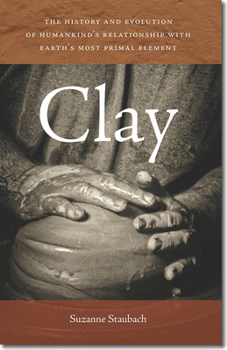Clay: The History and Evolution of Humankind's Relationship with Earth's Most Primal Element
Select Format
Select Condition 
Book Overview
Clay has played a crucial role in the development of the culinary arts, international trade, the invention of writing, and the construction of towns and cities. Now, Suzanne Staubach presents a look... This description may be from another edition of this product.
Format:Paperback
Language:English
ISBN:1611685036
ISBN13:9781611685039
Release Date:September 2013
Publisher:University Press of New England
Length:304 Pages
Weight:0.25 lbs.
Dimensions:0.9" x 5.4" x 8.4"
Age Range:18 years and up
Grade Range:Postsecondary and higher
Customer Reviews
3 ratings
Clay-tastic!
Published by Thriftbooks.com User , 14 years ago
I really enjoyed this wide-ranging and well-written book about wet, dry and baked mud's service to humanity, mud's more animate cousin. I highly recommend "Clay" for students, potters, ceramic collectors and the wider public.
Read about clay's multiple, vital roles in world history
Published by Thriftbooks.com User , 17 years ago
_Clay_ by Suzanne Staubach is an information-packed and interesting look at how one substance - clay - has had far-reaching effects on world history, culture, architecture, cuisine, and technology. Unbelievably abundant, clay (from kleben, German for "to stick to") is alumina, silica, and chemically bonded water. Its popularity through the ages is due to its abundance, plasticity, and its durability after being heated (even sun-baked clay has considerable durability, though unfired clay or raw clay has had a myriad of uses as well). Clay vessels have had a huge role in how humanity has cooked and stored food. With the advent of clay pots, it became possible to make grains and cereals into pottages, tough chunks of meat and tubers into stews, and babies could be weaned earlier thanks to easily-digested mush, which could easily be made in clay pots. Clay vessels made the brewing and consumption of alcohol possible, as pottery enabled the ancient Egyptians to brew ale; the Sumerians date wine; and the Egyptians, Greeks, and Romans grape wine. Interestingly, Roman wine was thick and intensely flavored and had to be mixed with water in specially-made clay vessels called kraters before drinking. Clay storage vessels also kept food safe from insects, rodents, and moisture. The first ovens were made of clay, enabling people to bake bread (especially raised bread). The Sumerians developed a large clay beehive oven called a tannur, a type that spread to many other parts of the world, including India, where it came to be called the tandoor. The tandoor is still in use today and tandoori cuisine is popular in many restaurants throughout the world. Also the very first stoves and ranges were made of clay and their remains have been found in ancient Mesopotamian, Chinese, and Roman archaeological sites. Potters became the world's first industrialists, as fired clay was the first synthetic substance ever created and the kiln and the potter's wheel were among the very first machines ever made. Indeed it is possible that the potter's wheel predates wheels used for transportation. Clay of course allowed people to produce plates, cups, and bowls for the dinner table, particularly after glazes were invented (the ancient Egyptians knew of two types of low-fire glazes, lead and alkaline). It was the Chinese who really advanced the art of producing dinnerware, producing the first porcelain in the Sui dynasty (the 500s AD), thought it was the later Ming dynasty (1368-1644) that became truly famous for it, its wonderful blue and white porcelains dishes a popular export commodity. The import of Ming porcelain vastly changed European tastes, leading to by the mid-16th century the need for aristocrats at least to have matching sets of china (as it became known). European potters were not to be outdone; Josiah Spode invented "bone china" or spode ware that thanks to bone ash from cattle had added stability and Josiah Wedgwood pioneered the idea of the assembly lin
Clay's vital role in modern times
Published by Thriftbooks.com User , 18 years ago
The effect of clay on civilization goes far beyond pottery efforts: it's fostered the rise of world trace, the invention of writing, and the construction of cities. It continues to play a vital role in our modern age, yet few outside of potters give it much attention. CLAY: THE HISTORY AND EVOLUTION OF HUMANKIND'S RELATIONSHIP WITH EARTH'S MOST PRIMAL ELEMENT will appeal primarily to any involved in the arts but is also a highly recommended pick for social science and history classes: it provides a lively look on all the elements clay has been essential to fostering, from semiconductors to surgical equipment.




